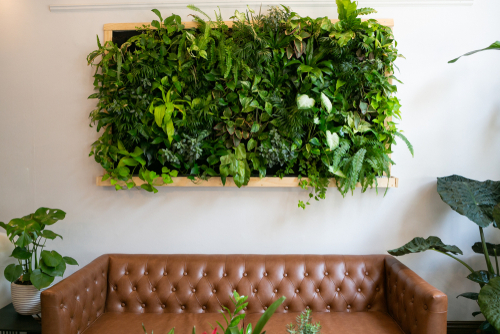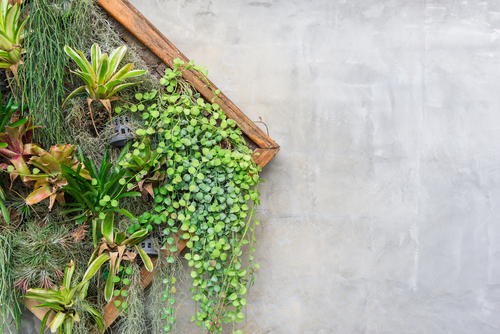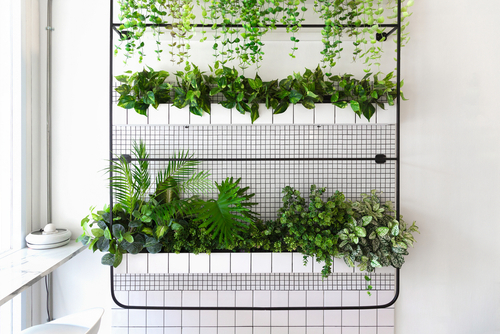
10 Creative Landscaping Ideas for Small Gardens
March 12, 2024
Top Landscaping Trends in Singapore
June 26, 2024Integrating Vertical Gardens into Urban Homes

Integrating-Vertical-Gardens-into-Urban-Homes
Integrating Vertical Gardens into Urban Homes. In recent years, the trend of vertical gardens has been gaining momentum, particularly in urban environments like Singapore.
These innovative green spaces offer a multitude of benefits for homeowners, ranging from space-saving solutions to aesthetic enhancements and environmental advantages.
In this article, we will delve into practical tips and considerations for integrating vertical gardens into urban homes, exploring everything from understanding the concept to installation and maintenance.
Understanding Vertical Gardens
Vertical gardens, also known as living walls or green walls, are innovative gardening systems that allow plants to grow vertically, either indoors or outdoors, instead of horizontally in traditional garden beds.
They utilize vertical space efficiently, making them ideal for urban environments with limited space.
The benefits of vertical gardens are manifold. Not only do they maximize space utilization, but they also contribute to air purification, biodiversity, and aesthetic appeal.
Vertical gardens can help reduce urban heat island effects, improve indoor air quality, and create visually stunning green spaces.
Assessing Your Space

Indoor vs. Outdoor Options
When considering vertical gardens, homeowners must first decide whether they prefer indoor or outdoor installations. Factors such as available space, lighting conditions, and desired aesthetic will influence this decision.
Vertical Garden Design
Assessing the layout and structure of your home is crucial for determining the most suitable areas for vertical garden installations. Consider factors such as wall strength, access to natural light, and proximity to water sources.
Choosing Suitable Plants
Choosing the right plants is essential for the success of your vertical garden. Factors to consider include light requirements, humidity tolerance, and maintenance needs.
Opt for plants that thrive in Singapore’s tropical climate and can withstand varying conditions.
In Singapore, a variety of plants are well-suited for vertical gardens.
Consider air-purifying varieties like pothos and snake plants, low-maintenance options like ferns and philodendrons, and tropical species such as orchids and bromeliads.
Vertical Garden Structures and Materials

Prefabricated vertical garden systems are readily available in the market, offering convenience and ease of installation.
Options include modular panels, hanging pots, and living walls, each with its unique features and benefits.
For those inclined towards creativity and customization, DIY vertical garden structures offer endless possibilities. Repurpose materials such as pallets, crates, and PVC pipes to create custom designs that suit your space and style.
Installation and Maintenance
Installing a vertical garden requires careful planning and execution. Prepare the wall surface, choose suitable mounting methods, and set up irrigation systems to ensure proper plant care and growth.
Regular maintenance is essential for the health and longevity of your vertical garden. Establish a watering schedule, prune plants as needed, fertilize periodically, and monitor for pests and diseases.
Lighting and Irrigation Considerations
Lighting Requirements
Proper lighting is crucial for the success of indoor vertical gardens. Maximize natural light exposure and supplement with artificial lighting as needed to ensure adequate plant growth and health.
Irrigation Systems
Choose the right irrigation system based on the size and complexity of your vertical garden. Options include drip systems, misters, and self-watering containers, each offering efficient water distribution and conservation.
Design and Aesthetics

Create visually appealing layouts by carefully selecting plant species, colors, and textures. Arrange plants in a way that maximizes visual impact and complements the surrounding environment.
Enhance the aesthetic appeal of your vertical garden by incorporating decorative elements such as trellises, sculptures, and lighting fixtures. These additions not only add visual interest but also contribute to the overall ambiance of the space.
Overcoming Challenges
Be vigilant against common pests and diseases that may affect your vertical garden. Monitor plants regularly, practice good hygiene, and employ natural pest control methods to prevent infestations.
Mitigate environmental factors such as wind, rain, and pollution that may impact the health and stability of your vertical garden. Install windbreaks, provide adequate drainage, and choose resilient plant species to withstand adverse conditions.
FAQ
Can I Install a Vertical Garden on Any Type of Wall?
While many walls can support a vertical garden, it’s essential to consider factors such as wall material, weight-bearing capacity, and exposure to sunlight.
Consult with a professional to assess the suitability of your chosen wall for vertical garden installation.
What Are Some Common Mistakes to Avoid When Maintaining a Vertical Garden?
Some common mistakes in vertical garden maintenance include overwatering, neglecting proper plant selection, insufficient lighting, and ignoring pest control. Educate yourself about best practices and seek guidance from experienced gardeners to avoid these pitfalls.
How Can I Ensure Proper Drainage for My Vertical Garden?
Proper drainage is crucial for the health of your vertical garden. Incorporate drainage layers or pockets within the structure to allow excess water to drain freely. Additionally, use well-draining soil and avoid waterlogging by monitoring irrigation levels closely.
What Are Some Alternative Planting Methods for Vertical Gardens?
In addition to traditional soil-based vertical gardens, alternative planting methods such as hydroponics, aeroponics, and aquaponics offer innovative ways to grow plants vertically. Explore these methods to discover new possibilities for your vertical garden.
Integrating Vertical Gardens into Urban Homes – Conclusion

In conclusion, integrating vertical gardens into urban homes offers a multitude of benefits for homeowners in Singapore.
By understanding the concept, assessing available space, choosing suitable plants, and implementing proper design and maintenance practices, homeowners can transform their living spaces into lush green havens.
Embrace the potential of vertical gardens to enhance your home’s aesthetics, improve air quality, and foster a deeper connection with nature.
Start your vertical gardening journey today and reap the rewards of a greener, healthier living environment!
Are you seeking a professional and reliable landscaping contractor or services in Singapore? Contact us today!




